National African American Museum and Cultural Center + Colonel Charles
Young's Home
Wilberforce, OH
1350 Brush Row Road
Wilberforce, Ohio 45384
Telephone: 937-376-4944
Fax: 937-376-2007
Hours:
Tues.-Sat.: 9:00 a.m. – 5:00 p.m.
Closed Mondays & holidays except M.L. King, Jr. Day
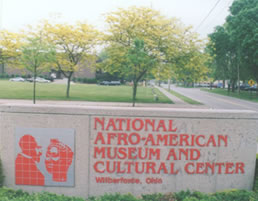
On May 10, 2006, the Buffalo Soldier Research Museum made site visits to the National Afro-American Museum and Cultural Center, Colonel Charles Young’s House, and the gravesites of Martin Delany and John Hanks Alexander. The trip from Indianapolis, Indiana to Xenia, Ohio is a 2.5 hour drive along Interstate 70. About 30 minutes east of Dayton, we traveled on back roads to the campuses of Wilberforce University and Central State University.
The National Afro-American Museum and Cultural Center opened its doors in 1988 and is located at 1350 Brush Row Road, Wilberforce, OH. It is adjacent to Central State University and is the original site of the old Wilberforce campus. Wilberforce is a famous stop on the Underground Railroad and is a symbol of freedom for the slaves. Together, Wilberforce and Central State have become a national center for black education and cultural studies. In recognition of that prominence, the US Congress established the National Afro-American Museum and Cultural Center (NAAMCC).
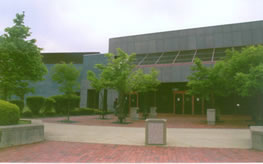
When we entered the NAAMCC, we noticed the large open space with lots of glass windows. The temporary exhibition space featured a doll and toy collection. The collection ranged from GI Joe to rag dolls to Barbie. In this area, there was a wall exhibit of posters depicting the life and work of Paul Laurence Dunbar, the first African American poet to garner national critical acclaim. He was born in Dayton, OH where he attended school and published his first collection of poems in 1892. During his short life of 33 years, he produced 12 books of poetry, four books of short stories, a play and five novels. We noticed poetry and other writings displayed in the museum.
The permanent exhibition offered a well-defined historical perspective of African-American history. A 1957 Chevy was on display; it was in mint condition and a 1950s-style barber shop was nearby. There were many rooms that displayed everyday lifestyles of African-Americans through the years. Nearly every area of life was illustrated-home, work, play, church, voting, civil rights struggles, war and peace. Many original artifacts were used to connect the past to the present.
The art gallery is named in honor of Paul Robeson. We discovered two works by Cincinnati artist, Robert Duncanson (1821-1872), who established himself as one of the first African American artists to gain international recognition. Other famous artists such as Elizabeth Catlett and Jacob Lawrence were on display with other less-known but exceptional artists.
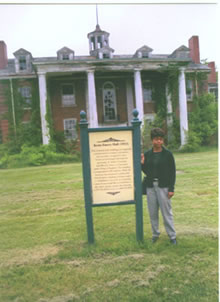
We walked to a nearby building that we thought was a library. It was next to an old dilapidated building that stands at the edge of the campus grounds. Grass had grown around it and vines were covering the walls. Windows were broken but it was easy to see the beautiful style and majestic nature of the building. A sign in front indicated that there are plans for the restoration of this elegant 120-room dormitory. We could feel the presence of mid-1860’s students studying, conversing, and living and learning. They were the backbone of the educated African American citizens at that time. Clearly, this restoration project will be costly but it will be well worth it. (Pictured at left: Carmon Hicks in front of dormitory.)
When we entered the “library,” we discovered that it was the administration building for the NAAMCC. We asked about the curator and the receptionist quickly ran to his office to inform him of our visit. Floyd Thomas, Ph.D., one of two curators, greeted us and after learning about our interest in Col. Charles Young, offered to show us Young’s home and gravesite. He was full of information about other African American soldiers (Martin Delany and John Hanks Alexander) and remarked about the many soldiers who were associated with Wilberforce University.
Thomas told us about that the museum has a national traveling exhibition loan program that was created to extend the museum’s collections, research, and expertise across the nation and around the world. This program offers large exhibitions such as Alex Haley, An American Griot, and an outreach component that brings smaller exhibits like Heroes of Our African American Heritage to museums, schools, and libraries.
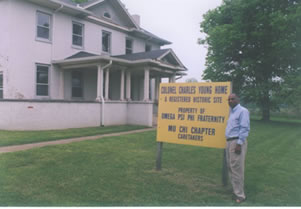
After nearly two hours of conversation about the Buffalo Soldiers, Wilberforce, the National Afro-American Museum and Cultural Center and historical details, we went to the home of Charles Young which is owned/used by the Omega Psi Phi fraternity. (George Hicks, II pictured at left in front of the Young home.) It is a large home with several stained glass windows, hardwood floors, wood trim in every room, and a trellis across the back of the home. As we were leaving, Thomas pointed out where the outdoor toilets were probably located in the backyard. He commented that they will research the toilet-area to learn more about the family. From the front porch windows, we could see the Christmas tree that the fraternity has used earlier that year. (Pictured below: Carmon Hicks and Floyd Thomas on the front porch.)
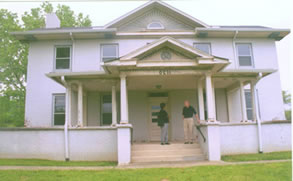
Here’s a little
history about Charles Young….
He was born in Mayslick, KY in 1864 and raised in Ripley, OH. His father
served in the Union Army as a blacksmith and livery stable operator. After
graduation from high school, Young taught school for several years. He applied
and was accepted to West Point Academy and, in 1889, was the third African
American graduate. He was the first black commissioned officer to command
a squadron of the 10th Cavalry. His first assignment was with the 10th Cavalry
in Nebraska and then with the 9th Cavalry in Utah. During the Spanish American
War (1898), he was reassigned as Second Lieutenant to Camp Algiers, Virginia
and later commanded a squadron of the 10th Cavalry in Cuba. Later, at Fort
Duchesne, Utah, he arbitrated a dispute between Native Americans and sheep
herders. He also served as professor of military science at Wilberforce
University (Charles Young pictured at right.).
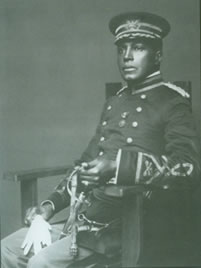
With the creation of the Army’s Military Information Division, he was assigned as one of the Army’s first military attaches in Port Au Prince, Haiti. His job was to observe training and exercises of foreign armies and report on their strengths and weaknesses. He also serves as Acting Superintendent of Sequoia National Park in California where he was responsible for the construction of roads in the park. His aggressive leadership style resulted in a road longer than all previous roads combined that opened the park to the public for the first time.
Young was sent to the Philippines in 1908 to command the 9th Cavalry and four years later was selected for military attaché duty in Liberia. He was awarded the Springarm Medal, an award that recognized the African American who made the highest achievement during the year in any field of honorable human endeavor.
During the1916 Pershing Punitive Expedition into Mexico, Young commanded a squadron of the 10th Cavalry and led a pistol charge against Poncho Villa’s forces without losing a single man. He was also credited with averting disaster when he and his men rescued the 13th Cavalry. Because of his exceptional leadership in Mexico, Brig. General John Pershing appointed Young to Lieutenant Colonel and was briefly commander at Fort Huachuca, Arizona.
Young was devoted to his wife, Ada and their two children, Charles and Marie. He played the piano, violin, and guitar and spoke several languages. He was the highest ranking African American officer during WWI and was the first black to reach this rank.
Young was medically retired in 1917 for high blood pressure and Bright’s disease. To prove he was fit at age 53, he rode his horse “dolly” from his home in Wilberforce, OH to Washington DC. Sixteen days and neatly 500 miles later when he reached the War Department (now the Pentagon), there was a flood of letters of support for Young. Colonel Charles Young was reinstated to active duty as a full colonel and returned to West Africa for a research expedition in Lagos, Nigeria but died at that post in 1922. His body is buried in Arlington National Cemetery near Washington DC.
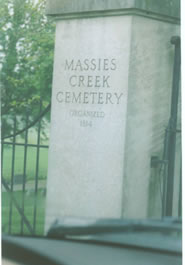
Back to our journey….
Next, we visited Massie Creek cemetery to visit Martin Robison Delany’s
gravesite. The cemetery sits on a hill in an open field; however, the cemetery
had many full-grown trees. Thomas told us that this was one of the
first integrated cemeteries. He described the black granite used for the
tombstone and showed us the back side that described Delany’s importance.
The granite was imported from Africa.
Martin Robison Delany has been called the “Father of Black Nationalism” because
he aggressively promoted black pride and self-reliance. He was born May 6,
1812, in present-day West Virginia, where it was illegal for him to learn
to read and write. Fearing prosecution, his family moved to Pennsylvania,
where he could attend school. Many years later he would move his own family
to Wilberforce, Ohio, so that his children could obtain a quality education.
Throughout his adult life, Delany was an advocate for Americans of African
descent. He founded and published a Black newspaper, The Mystery, in Pittsburgh
and later co-edited The North Star with abolitionist Frederick Douglas. Wanting
to provide care to the community, Delany was among the first African Americans
admitted to Harvard University Medical School. Prior to the Civil War, he
criticized the government for permitting slavery and abolitionists who lacked
commitment to Black equality and justice. Concerned that slavery in America
would never end, Delany traveled to Africa to secure a homeland for Black
Americans.
With the outbreak of the Civil War, Delany had renewed hope that all African Americans would be free. He recruited Black troops for the Union Army and met President Abraham Lincoln to discuss a strategy for ending the war. Lincoln appointed Delany a major, making him the highest ranking field-grade officer in the U.S. Colored Troops. Following the war, Delany served in the Freedman’s Bureau to protect the rights of former slaves.
Delany was an abolitionist, a physician, a leader in Prince Hall Freemasonry, an inventor, a judge and a prolific writer. In everything he did, Delany was a practical man, determined to achieve freedom and justice for African Americans. He died January 24, 1885, in Wilberforce, and is buried just two miles from his family home.
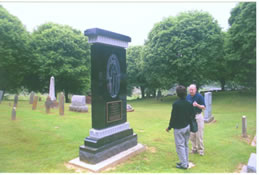
His final resting place was marked with a small government issued tombstone-with his name misspelled. This headstone has been replaced with $18,000 Black African granite to reflect Delany’s pride in his ancestral homeland, and it features an engraving of Delany as a major in the Civil War. A Dayton, Ohio television station WDTN-TV-2 was the campaign sponsor and Dayton Power and Light Foundation committed $5,000 for this effort.
Our final stop at Cedar Grove cemetery in Xenia was to see John Hanks Alexander’s gravesite. It was small and non-descript. The tombstone was chipped and no one would even know that he was second African American graduate from the United States Military Academy. It was only fitting that we had run out of film and did not get a photo of his small gravesite. John was born January 6, 1864 at Helena, Arkansas (Phillips County) to former slaves James Milo Alexander and Fannie Miller Alexandria. His father was a barber in Helena and acquired property there. All of the Alexander children graduated from high school and three attended Oberlin College in Ohio.
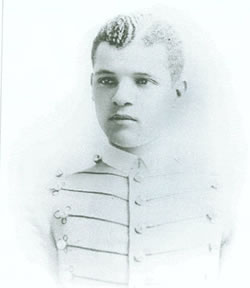
John Hanks Alexander (pictured at right) graduated number one in his high school class in Helena and moved to Carrolton, Mississippi to take a teaching position. In 1880, he visited his uncle in Cincinnati, Ohio and remained there. The next year, he enrolled at Oberlin College and attended that institution until passing the entrance examination for West Point in 1883. Alexander was sponsored by Democratic U.S. Rep. George W. Geddes of Ohio.
During his term at West Point, Alexander was generally accepted by other
cadets and was not subjected to as much intolerance as previous cadets. He
was known as an excellent student, especially in mathematics and languages
and was a skilled boxer while at the academy. He graduated in the class of
1887 ranking 32nd in a class of 64.
Alexander was assigned to the United States 9th Horse Cavalry Regiment at
Fort Robinson, Nebraska which was an all black regiment commanded by white
officers and nicknamed Buffalo Soldiers/ Alexander became the only black
officer in an actual command position. In 1888 he was transferred to Fort
Washakie, Wyoming where he engaged in the normal activities of an officer
with a western frontier post.
In 1894, Alexander was assigned to Wilberforce University as a military science and tactics professor. Shortly after arriving he died unexpectedly of a ruptured aorta on March 26, 1894. A military installation at Newport News, Virginia was named Camp Alexander in his honor.
Sources:
Heartland Chapter Newsletter, volume 1, issue 5, November/December 1999,
Cincinnati, OH.
Personal conversation with Dr. Floyd Thomas, Jr. Chief Curator National Afro-American Museum and Cultural Center, May 10, 2006.
http://en.wikipedia.org/wiki/John
Hanks Alexander. Retrieved 5/22/06.
www.bjmrj.com/delany/home.htm Submitted
by F. Thomas Jr. Retrieved 5/22/06
www.buffalosoldier.net/Charles
Young.htm. Retrieved 5/8/06.
www.dunbarsite.org/biopld.asp.
Retrieved 5/22/06
www.encyclopediaofarkansas.net/encyclopedia/media-detail.asp.
Retrieved 5/24/06
The Buffalo Soldiers Research Museum recommends visiting this historical Museum and the sites we featured during our visit. Wilberforce University and Central State College are adjacent to the museum. The Col. Charles Young house is now being used as a meeting place. There is an effort under way to raise funds to convert this historical house to a museum. For more information on this project contact Dr. Floyd Thomas.
